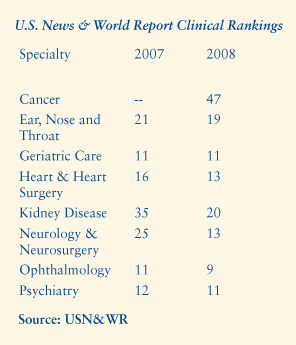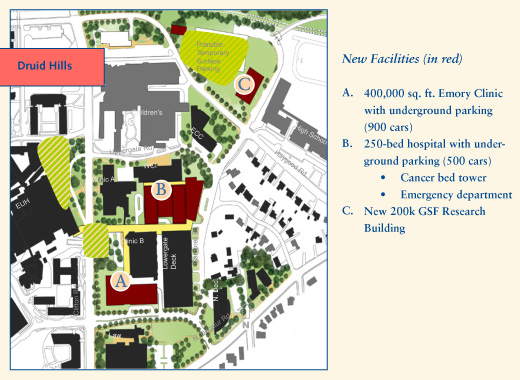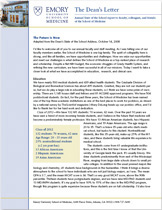Clinical Care

U.S. News and World Report ranked seven of our programs in the top 25. Cancer made the rankings for the first time. The Emory Winship Cancer Institute went through a site visit for NCI cancer status, a wonderful effort on the part of a lot of people. The collaborators I’m going to expand upon are our major ones, though we have lots of collaborations that take place within the health sciences center, within the college, and other places within Emory.
Emory Healthcare
Emory Healthcare had another terrific year. The leadership of John Fox and Wright Caughman has been nothing short of stellar. They maintained positive bottom lines in the clinic and the hospitals, and in this day and age that is not an easy thing to do. There were 48,500 patient admissions into Emory hospitals and almost 2 million patient visits to Emory Clinic. Both figures are a tribute to Emory Healthcare and faculty.
Emory Healthcare will see some major changes in the next few years. A strategic plan calls for the construction of new Emory University Hospital and Emory Clinic facilities on Clifton Road. The new clinic building will be about 400,000 sq. ft. Around the corner will be our new research building that I mentioned earlier.
The Midtown master plan is a bit less advanced than the Clifton Road project but again points out the need for new hospital beds, as well as research space. We believe that we will build approximately 100,000 sq. ft. of research space there. There is an enormous amount of planning going on due to the leadership of Fred Sanfilippo, executive vice president for health affairs, and things are moving ahead.
These new facilities will enable us to deliver better patient-centered care. They will create opportunities for enhanced efficiency, and that’s good for our patients, physicians, and nurses. These facilities and the atmosphere of collegiality that you create are going to make Emory an evermore attractive place for patients and employees.

This past year Emory Healthcare established a system-wide quality office and a quality council and installed chief quality officers at each hospital and clinic. William Bornstein, chief quality officer for Emory Healthcare, has been the point person for these efforts, and he deserves great credit. A number of you have been involved in the quality committees and quality and safety exercises. I, too, participated recently in a quality-control exercise. I donned scrubs and went into a storage room at Emory University Hospital and worked with a team to help clean out old supplies and organize others. We found that trying to locate three items before the clean-out took 13 minutes, and afterward, just three minutes. It’s a telling example of how quality control affects day-to-day jobs.
In the past several years there has been a national emphasis on measurably enhancing quality of patient care. Emory has embraced these principles. There is a significant effort under way to educate everyone on the importance of creating a culture of quality and safety that should pervade everything we do. As we examine policies and procedures to enhance quality and safety for our patients, we need the wholehearted cooperation of our faculty. We want Emory to be a leader in quality of care, and with hard work, dedication, and your cooperation, we will achieve it. Emory Healthcare also wants to implement clinical-improvement processes, accelerate the implementation of patient- and family-centered care, use a computerized provider order entry system for all inpatient settings in the coming year, complete preparation for a magnet designation application by the end of 2009, and increase patient satisfaction results system-wide. Under the leadership in the Woodruff Health Sciences Center and Emory Healthcare, there’s no question that these efforts will be successful.
Atlanta VA Medical Center
With its leadership team of James Clark, David Bower, Tony Laraquente, Robert Pollet, and Norberto Fas, the VA and the school continue a great relationship. There are 203 faculty and 133 residents who are paid in part or exclusively by the VA. We have about 660,000 outpatient visits, and the research enterprise is now up to $29 million there. We are coordinating a VA human study center with David Stephens of the Atlanta Clinical and Translational Science Institute and increasing mental health research on veterans who served in Afghanistan and Iraq who have traumatic brain injury or posttraumatic stress disorder. It’s a great relationship and one that we prize. And we have a pedestrian bridge now that joins the Emory and VA campuses. It took a lot of time, about a decade, but we finally got it!
Children’s Healthcare of Atlanta—This is another important collaboration for us, with its leadership team of Donna Hyland, Jay Berkelhamer, and our own pediatrics department chair Barbara Stoll. Together, we formed the Emory-Children’s Center in 2006 to house our pediatric practice, and that has made great progress. We also are jointly recruiting a Children’s Healthcare chief research officer.
We are active partners in strategic planning for Children’s, what they refer to as Vision 2018. Their vision includes increasing access, physician alignment, and the numbers and growth of centers of excellence. They want a world-class pediatrics facility. They want to have a research engine that generates significant external support. They want to be the wellness leader in Georgia and a model for the country. They want financial growth and stability, and they want to increase their fund-raising. This is a wonderful vision for them. It includes us, and I am confident we will be successful together.
Grady Hospital
We’ve partnered with Grady since 1892, and we provide more than 600 physicians and 375 residents there. In fact, those physicians and residents make up 80% to 85% of Grady’s staff. The Morehouse School of Medicine provides the rest. Together the two schools oversee about 800,000 outpatient visits and about 31,000 admissions each year.
The good news is that Grady has a new board of directors and new CEO, Michael Young. I have had the opportunity to meet with him on a number of occasions since he joined Grady on September 1. I must say he’s off to a fast start as he begins the task of reinvigorating and rejuvenating Grady.
There are many opportunities at Grady to improve care, education, and research. One such opportunity I talked with Mr. Young about is the creation of a center for neurosciences that would focus much of its effort on the diagnosis and rapid treatment of stroke. There’s nothing quite like that in Atlanta. We can bring to bear all of the applicable specialties that would be necessary for this, neurology, neurosurgery, and rehabilitation medicine, among others. The conversations about this indicate to me that Grady has turned the corner. We’re not talking now about merely saving Grady. We’re not talking about Grady merely surviving but about creating a center of excellence that’s unique for Atlanta, and that’s a huge change.
On the front burner for us at Grady is the 2009 budget. William Casarella and I continue to work through budget issues with our Grady colleagues. We have made it clear that we cannot continue to subsidize Grady at the rate that we have been called on to do in the past. At the same time, though, we are hopeful that we will be able to work through these issues and maintain a very strong presence at Grady.

